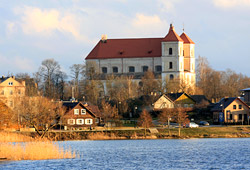History
The name “Trakai” most likely originally belonged to the place now known as Old Trakai, 4 kilometres southeast of the current town and its lakes. By order of the Grand Duke of Lithuania, a castle was built there in the 13th century as a residence for the ruler. It briefly served as the Lithuanian capital, until Vilnius assumed that function. The current town of Trakai, also known as “New Trakai”, became the second most important political and administrative centre in the Grand Duchy of Lithuania, after Vilnius, around 1375, when Grand Duke Kęstutis (c.1297–1382) moved here and began construction of a castle on the peninsula. The Trakai island castle dates to around the start of the 15th century. The town, which obtained Magdeburg rights in 1409, flourished in the 15th and 16th centuries, after which its importance diminished.
Lithuanian Grand Duke Vytautas (c.1350–1430) founded the parish church of Trakai on May 24, 1409. It was named in honour of the Blessed Virgin Mary‘s Visitation and St John the Evangelist. When exactly construction was completed is unknown. The pastor of the church is mentioned in a document from 1479, which shows that the sanctuary had by then been blessed and was functioning. Construction most likely took place between 1415 and 1425. The red brick gothic edifice then remained just as it was built until the early 17th century, when a vestibule was added. Around that time, the church began to gain fame for graces associated with a miraculous image of the Mother of God. Historical documents refer to a growing numbers of pilgrims, while the church property register lists gifts that were left by the picture in thanksgiving.
The church, damaged and looted during war with Moscow between 1655 and 1661, gained many baroque features during later reconstruction. The Römer Family Chapel was built by the southern wall of the presbytery in 1700, and within a few years, the church itself underwent renovations once more to prepare for the solemn coronation of the Trakai Mother of God in 1718. A fire that occurred during a popular uprising in 1794 destroyed the church’s organ and damaged its roof. In the 20th century, the building suffered during the two world wars and then was neglected during the Soviet years. Intense renovation work took place during 2007 and 2008.








